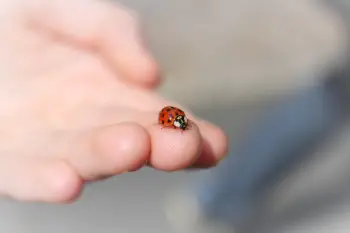Considered a good luck symbol by many, the bright red-colored ladybugs are perhaps the most loved insects of all. These cute little harmless insects have made their way into children’s storybooks, with a whole publishing company, ladybird, named after them.
Do Ladybugs bite? Yes, some can cause a nip, but they cannot break through human skin. Ladybugs feed on other insects, they have chewing mouthparts, but their mandibles (chewing parts) are designed for chewing on soft-bodied insects. In most cases, they bite if threatened or if they mistake you for a meal.
Let’s investigate further…
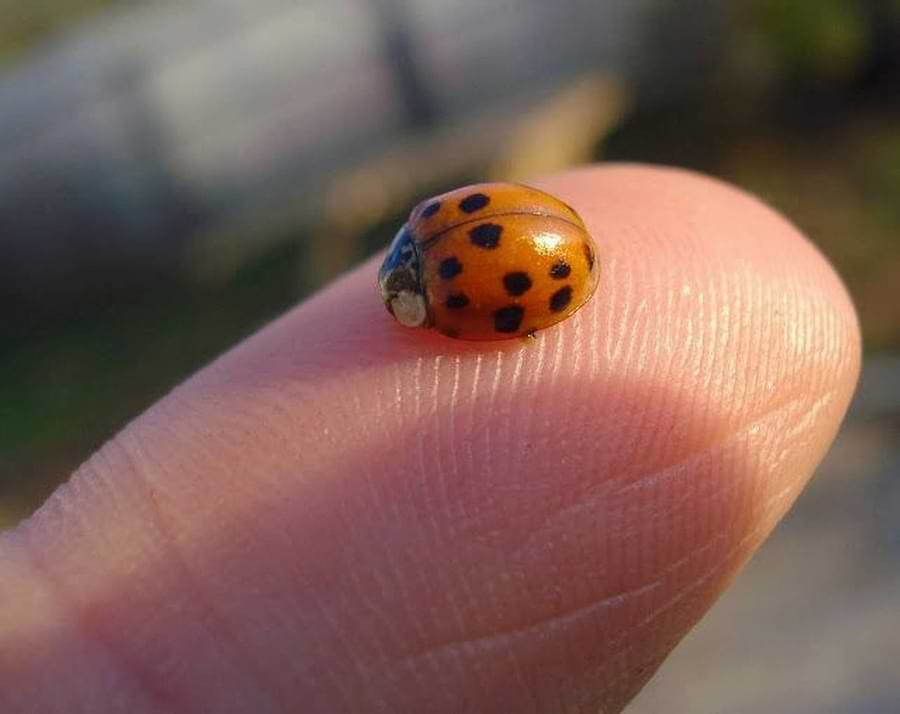
These vibrant-colored ladybugs with all kinds of spots come in a lot of varieties, and whether you end up getting bitten by a ladybug or not also depends on the type of Ladybug in question and their motive!
Why Do Ladybugs Bite?
Traditionally ladybugs feed on agricultural pests and small insects like aphids; therefore they’re usually a joyful sight for farmers. Since their mouths are specialized only for feeding on soft-bodied insects they generally don’t tend to “bite” humans even if they land on the skin’s surface. The most they do is scratch on the skin surface which results in a mild ‘nip’.
However, these spotted little insects are fighters and take extreme measures for survival. Ladybugs often lay an increased number of infertile eggs during tough times to provide sustenance to their young hatchlings.
In times of scarcity, hungry ladybugs eat up their own siblings, so it would not be surprising that they might resort to biting humans as well to survive.
The Asian Harlequin ladybug is the most notorious in this regard. When liquid nourishment is in short supply, they will be more tempted to bite humans to satiate themselves. Some ladybug species also bite humans in order to obtain salt.
Do All Lady Bugs Bite?
While all ladybugs can bite, it is usually the Asian Harlequin variety of ladybugs that are most known for biting people.
According to experts, the harlequin ladybug is more likely to bite people during a scarcity of food. In fact, as reported by the telegraph, the heat stroke of 2013 caused the ladybugs to turn to human flesh for fluid replenishment.
However, this isn’t the first time that Ladybugs have turned to humans for their sustenance.
In 1976, during a period when the aphid population dried up, the ladybugs started biting people in an attempt to get nourishment.
While all ladybugs look almost similar, the Asian Lady Beetle has a distinguishing feature- a larger white area on its head. And according to guidelines published by the Harlequin Ladybird Society, you can identify a Harlequin ladybug from its large size and a white spot behind its head.
Apart from these two distinguishing features, the Asian harlequin ladybug very much resembles the native Ladybug. They are both usually bright Red or Orange in color with orange or black spots which may range from zero to 21.
Are Ladybugs Dangerous to Humans?
I don’t for one second want you to flinch every time a Ladybug lands on your hand or arm, or anywhere else. No, they are not considered dangerous to humans.
Ladybugs, for the most part, are harmless. The risk of being bitten just from it being on the skin is very slim. The resulting issues and problems that could arise from any subsequent bite are extremely slim too. For the majority, and particularly for children, they’re just considered cute – not to mention extremely beneficial and important to humans for a number of reasons in gardens and crops.
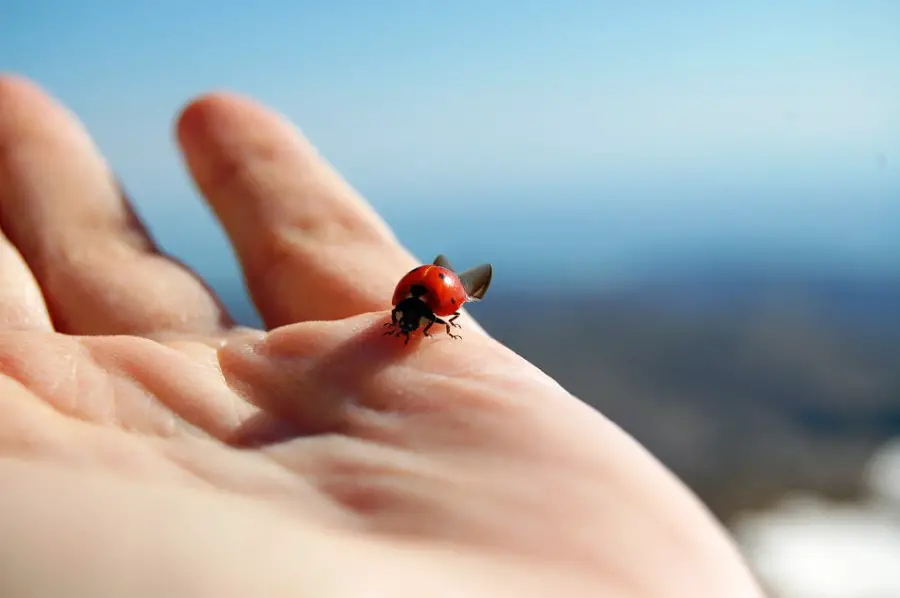
What Threats Do Ladybugs Pose to Humans?
The Asian ladybug has a reputation for biting humans when the aphid supply becomes low. And Asian Lady Beetles have a voracious appetite and can take extreme measures for survival.
They have the ability to adapt to almost all kinds of habitats and are designed to find the source of survival in any of them.
Twice, in 1979 and 2013, newspapers reported Asian ladybugs turning to human flesh for their survival. While there haven’t been any serious cases reported until now, except for mild inflammation and allergic reaction, it doesn’t hurt to be careful.
But, Asian ladybugs going about biting humans isn’t the only problem they pose. In North America, the Asian Ladybird is referred to as the ‘Halloween Bug’ because it congregates in huge numbers in people’s houses during the month of October.
While the Asian Ladybug bite isn’t harmful, it does leave behind a slightly painful bump and, sometimes can pose an allergic reaction in some people.
Allergic reaction from ladybug bite
The most common allergic reaction is “rhinoconjunctivitis” caused by touching a ladybug and then rubbing your eyes with that hand. However, in some cases, the allergic reaction can be severe enough to require treatment.
In November 2016, Reza Rezamand, a professional bodybuilder, nearly died after being bitten by an Asian ladybug. On November 2016, when Reza walked towards his car he saw that the roof and door of his car had lots of ladybugs on them.
He couldn’t help but notice that they looked a little different; larger and black-colored with orange dots.
After letting them walk over his hand, he brushed them off and got in his car. Not much later he started experiencing sharp pain on the left side of his neck which then spread towards his left foot.
The pain in his foot worsened, accompanied by a burning sensation, and by the next day, his foot was swollen and still hurting. He couldn’t walk due to the pain and by the evening his foot was black and he was rushed to the hospital.
At the hospital, the doctor discovered that Reza’s body was trying to fight an infection which was unusual as Reza, at 31, has always been fit and never got ill.
Later it was found that Reza had severe sepsis (a life-threatening illness caused by your body’s response to an infection), caused by the bite of an Asian ladybug that carries a fungal disease in its saliva.
The saliva had entered Reza’s system through his skin, and he had to be put on strong antibiotics and morphine with the possibility of amputating his leg.
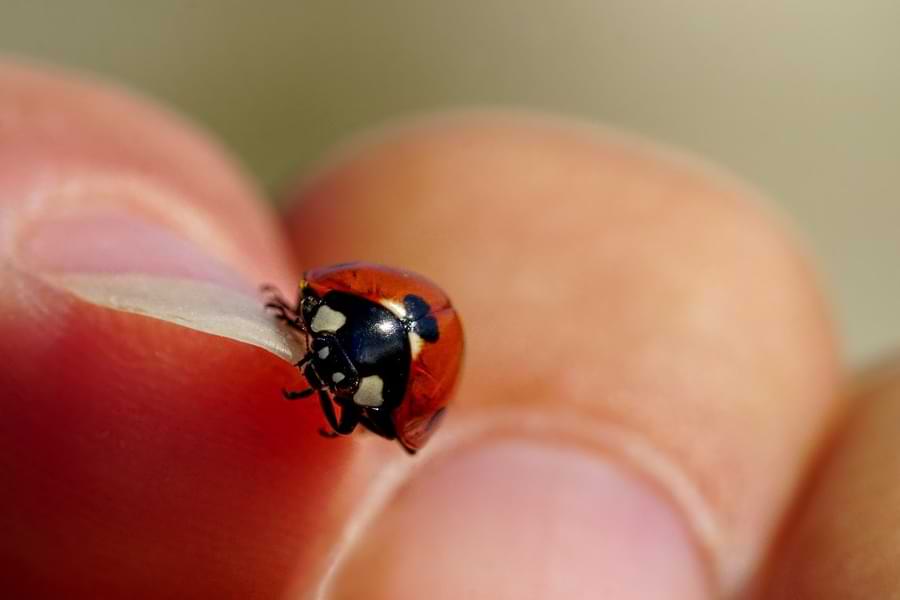
Lucky escape following ladybug bite reaction
Reza was lucky because with the severity of sepsis he had his odds of survival were slim, as one out of every three people die.
Nevertheless, Reza still suffered some serious side effects; for a long time he was unable to walk properly and his weight was reduced from 100 kg to 75 kg. For a professional bodybuilder like Reza, this was a very hard blow.
In an interview with The Sun, Reza said, “I want to raise awareness about this and tell anyone who might have suffered a similar bite to go to the doctor straight away”.
While what happened to Reza is extremely rare, it’s important to learn to not take such a situation so lightly, as Reza himself acknowledges how ignoring what happened to him could have cost him his life.
Where Do Ladybugs Bite Humans?
If you were to be bitten by a Ladybug, this is not because they target particular areas of the skin. Most bites occur on exposed areas where Ladybugs are more likely to land, such as hands, arms, neck, and head.
Where a Ladybug may become tangled in clothing that is next to the skin may cause them to become distressed and react out of protective instinct. But again this won’t be aimed at any one particular bodily area.
Here’s a short video of Asian Lady Beetles biting (or attempting to bite) someone’s hand
What Happens If a Ladybug Bites You
More often than not, ladybugs don’t bite. The mandibles of ladybugs aren’t strong enough to break through human skin or cause bleeding.
But, if you do happen to be bitten by a ladybug you may end up with a mildly painful but harmless bump and a red area of skin.
However, the Asian Harlequin ladybug variety is more likely to bite and is more aggressive compared to the native varieties.
In extremely rare cases, and where the recipient may be prone to allergies, a bite by the Asian ladybug may cause an allergic reaction, from eye infections to nausea, hives, asthma, or hay fever.
A word of caution, rubbing your eyes after touching a ladybug may trigger eye infections such as conjunctivitis.
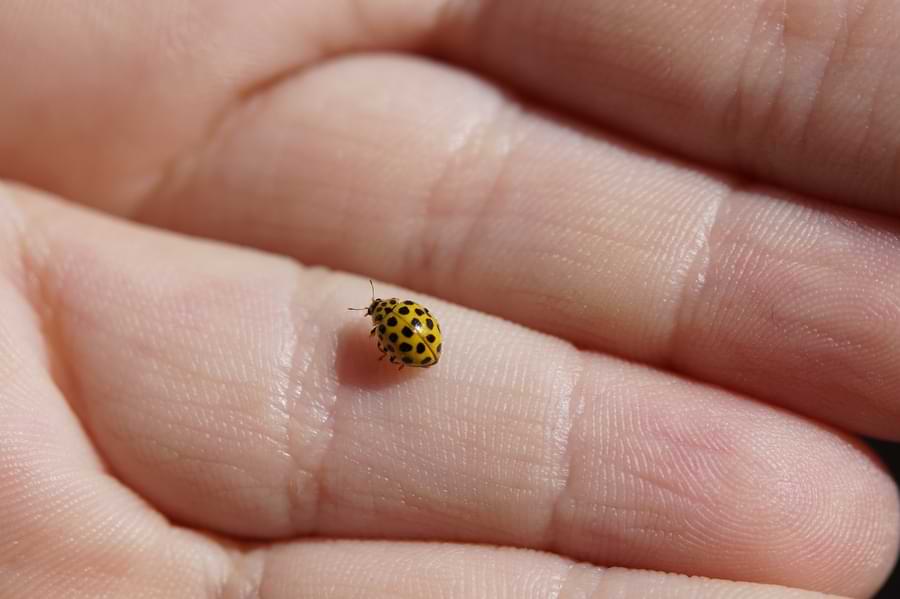
Are Ladybugs Poisonous?
While ladybugs are poisonous to some smaller animals, they don’t have a toxic effect on humans. According to research done at the University of Exeter, the brightness of a ladybug’s color indicates its extent of toxicity.
A ladybug with more vibrant color is less likely to be attacked by predators, particularly those with vibrant red Elytra (wings), as red and even orange are considered to be prominent warning colors in nature.
But, there are still animals that eat Ladybugs
Find them here
The researchers analyzed the toxicity of five common ladybug species by counting the number of dead Daphnia in water containing toxins from different ladybugs.
The results of the research revealed that the ladybugs with the most conspicuous and bright color had a stronger defense mechanism. Ladybugs with inconspicuous color, with respect to their surrounding vegetation, showed lower levels of defense.
All Ladybugs have five defense mechanisms, one of which is known as ‘reflex bleeding.’ This blood contains high amounts of the chemical Isopropyl Methoxy Pyrazine in their hemolymph.
On feeling threatened, the Asian ladybug bleeds from their knees, excreting the foul-smelling yellow hemolymph from its joints that deter the predator from eating them.
This yellow liquid, with a foul odor and even more foul taste, is similar to that of dead leaves, the liquid leaves behind a residue that stains surfaces and may cause an allergic reaction in humans, but it is not poisonous.

Ladybug Bite? or Sting?
It should be noted that, unlike bees and wasps, there are no physical parts of the Ladybug that are inserted into the skin. There are also no toxins injected into the skin, any reactions are purely based on the bite alone and a reaction to the connection of the Ladybug Mandibles to the skin.
How Do Ladybugs Bite?
You can see from Fig 1. below, the mandibles are what is used to pierce soft-bodied insects. It is these mandibles that will be used if a Ladybug is trying to bite you.
The size of mandibles can vary slightly from variety to variety, and they may be slightly larger when viewed from a lower angle than depicted. But you can tell by the size depicted in Fig 1. That they’re not generally large enough, or strong enough to inflict any damage.
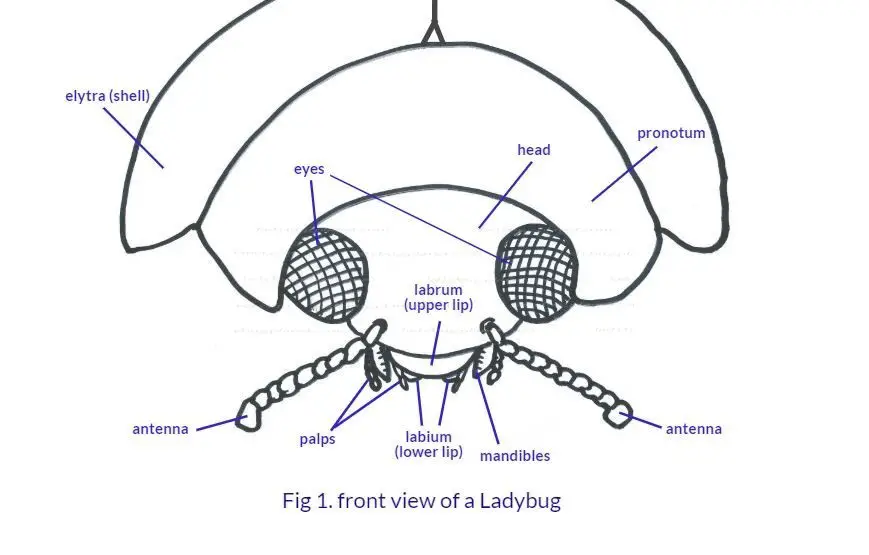
As

How to Treat A Ladybug Bite
Ladybugs don’t have venomous glands, so a ladybug sting, or bite, isn’t something to worry about. While the sting can be slightly painful, washing the affected area with mild soap and water is usually enough to prevent the risk of infection.
However, if you’ve been bitten by the harlequin variety of ladybugs you may end up with a bump and sting and, in rare cases, an allergic reaction. The general method to treat such a bite, as advised by the health body is as follows;
- Immediately wash the affected area with mild soap and water.
- Apply an ice pack or cold compress to the affected area for at least 10 minutes.
- To help reduce swelling elevate the affected area.
- Steer clear of home remedies.
- Avoid scratching to prevent the onset and spread of infection.
If symptoms persist, or if you are at all concerned, then contact your local health practice to obtain professional advice.
Threat Posed to Other Species by the Asian Lady Beetle
Asian ladybugs have been declared as the second most significant threat to biodiversity after habitat loss. According to research, Asian Ladybirds pose a threat to biodiversity due to their voracious appetites and competition for food and habitat with other invertebrates.
They have been also declared as UK’s fastest-invading species to have spread almost all over the country in just a decade. Leaving the gray squirrel, American mink, and muntjac deer far behind.
One of the greatest threats they pose is to the native ladybugs. The Asian ladybug is believed to be responsible for the decline of the popular two-spot and seven-spot species of the native ladybug, and five more native species as well.
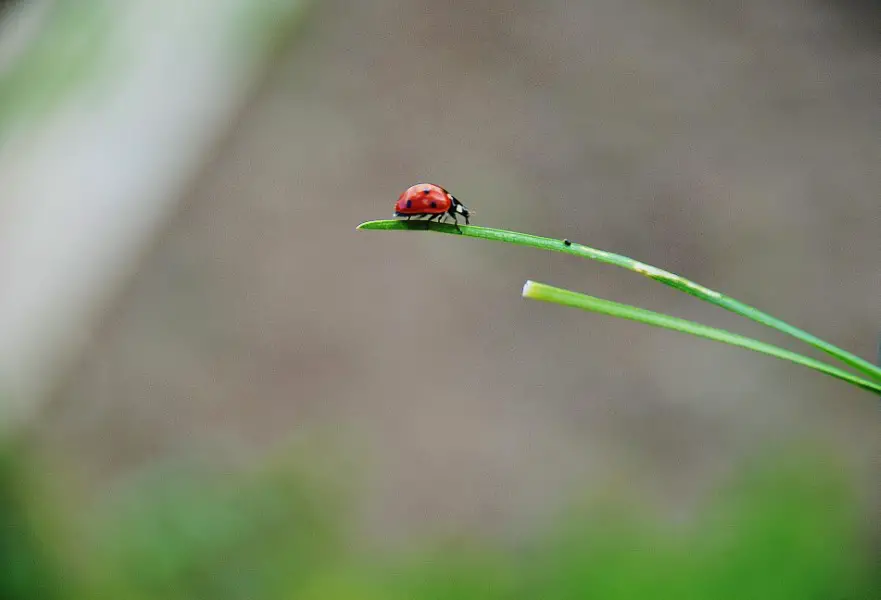
Dr. Helen Roy, of the Centre for Ecology and Hydrology, reported that the number of two-spotted native ladybug species has gone down by 44% since it was last assessed in 2012 and there seems to be no chance for its recovery.
The Asian ladybug doesn’t just compete with the native ones for food but also poses a threat to them by predating on their eggs and larvae.
Not only are Asian ladybugs hardier than the native ones, but they also contain fungus-like parasites that infect and kill native ladybugs, says a study published in science. This fungal parasite, called microsporidia is what makes the Asian ladybugs so deadly
The Final Verdict
So, after our extensive discussion, we can conclude that ladybugs do bite humans, especially the Asian ladybug, but only when the food supply is scarce, or they’re attracted to the salty skin, or if they mistake you for food
Also, a ladybug’s bite doesn’t pose any significant harm to humans, in the vast majority of cases, causing only a red mark and a mild bump, and potentially a mild allergic reaction at most.
Related Questions:
What does a ladybug smell like? When threatened, Ladybugs will ‘reflex bleed’ from their leg joints called hemolymph. This chemical, called Isopropyl Methoxy Pyrazine is toxic to other insects and some animals. This chemical is generated internally and they can also smell of it when you’re up close. To humans, the smell is akin to rotting or dead leaves.
Can a Ladybug bite kill you? There are no recorded deaths attributed to Ladybug bites. There are however extremely rare occurrences of allergic reactions as a result of a Ladybug bite. Mild symptoms can be experienced, but death is almost impossible unless you consume hundreds – if not thousands of Ladybugs.
What happens if you swallow a ladybug? Not much, the smell and the resulting taste will be unpleasant. There are no known cases of swallowed Ladybugs causing any internal issues. It’s not advisable to eat or swallow a ladybug as they contain almost no nutritional value. Moreover, much of the wings and exoskeleton are indigestible anyway

